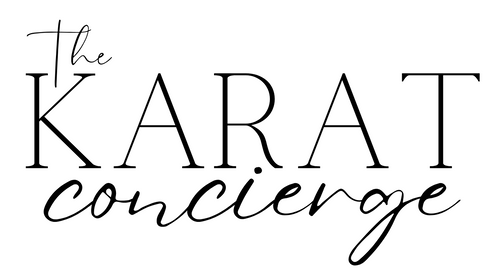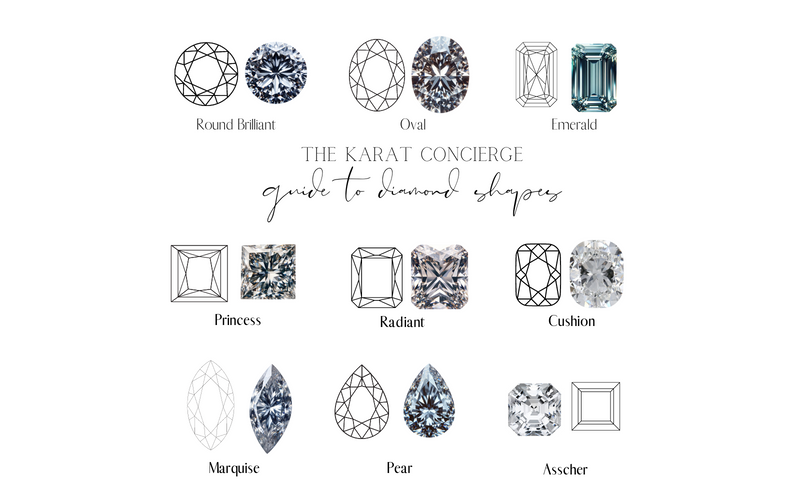Selecting the perfect diamond shape for your engagement ring or jewelry is a momentous decision. The shape not only defines the appearance of the diamond but also influences how it interacts with light and reveals its unique characteristics, such as color and inclusions. In this guide, we'll explore popular diamond shapes, discussing their individual qualities, and how they affect clarity characteristics.
- Round Brilliant Cut

The round brilliant cut is the most iconic and timeless diamond shape, renowned for its exceptional sparkle. With 57-58 facets designed to maximize light reflection and refraction, round diamonds exhibit unparalleled brilliance. They are also adept at concealing both color and inclusions due to their brilliant optical properties.
Advantages:
- Outstanding brilliance and sparkle
- Effective at hiding color and inclusions
- Versatile and classic, suitable for various settings
Disadvantages:
- Often comes at a premium price due to high demand
- Requires precise cutting for optimal brilliance
- Princess Cut

The princess cut offers a modern and elegant appearance with its square or rectangular shape, sharp corners, and pointed facets. It rivals the round brilliant cut in terms of brilliance and sparkle. However, princess-cut diamonds may be more prone to revealing inclusions in their pointed corners.
Advantages:
- Contemporary and distinct look
- Excellent brilliance and fire
- Typically more budget-friendly than round diamonds
Disadvantages:
- Vulnerable to chipping at pointed corners
- Inclusions may be more visible in these corners
- Emerald Cut

Emerald-cut diamonds have a rectangular shape with cut corners, creating a mesmerizing hall-of-mirrors effect due to their step-cut facets. This shape exudes understated elegance and is known for its clarity, as it tends to reveal inclusions more readily. However, color may be more noticeable in emerald-cut diamonds due to their larger table facets.
Advantages:
- Unique and sophisticated appearance
- Exceptional clarity characteristics
- Appears larger for its carat weight
- Shows less color than it's equivalent color grade in a faceted cut shape
Disadvantages:
- Prone to revealing inclusions
- Oval Cut

Oval-cut diamonds combine the brilliance of the round shape with an elongated, graceful appearance. They have gained popularity in recent years. Oval diamonds are effective at concealing inclusions but can occasionally display the "bowtie effect," a dark area across the center that can impact sparkle.
Advantages:
- Unique and elongated look
- Hides inclusions effectively
- Appears larger than its carat weight
Disadvantages:
- Potential for the "bowtie effect" in the center
- Requires careful selection to avoid color variations
- Marquise Cut

The marquise cut boasts a distinctive shape with pointed ends and an elongated, boat-like silhouette. It imparts an elegant and elongating effect to the fingers. Marquise diamonds typically hide inclusions well, but like oval cuts, they can exhibit the "bowtie effect."
Advantages:
- Unique and elongated appearance
- Good at concealing inclusions
- Creates an illusion of longer fingers
Disadvantages:
- Susceptible to the "bowtie effect"
- Prone to chipping at the pointed ends
- Pear Shape

Pear-shaped diamonds combine the elegance of a round shape with a tapered point, resembling a teardrop. They offer a romantic and timeless appearance. Pear diamonds effectively hide inclusions but may also display a "bowtie effect" similar to marquise and oval shapes.
Advantages:
- Romantic and distinctive shape
- Hides inclusions well
- Provides an elongating effect for the hand
Disadvantages:
- Prone to the "bowtie effect"
- Requires careful selection to avoid color disparities
- Radiant Cut

The radiant cut combines the elegance of an emerald shape with the brilliance of a round brilliant cut. It features beveled corners and 70 facets that maximize light reflection, resulting in a dazzling appearance. Radiant-cut diamonds are known for their ability to hide inclusions well but may reveal color more readily due to their larger table facets.
Advantages:
- Brilliant sparkle and fire
- Good at concealing inclusions
- Versatile and unique shape
Disadvantages:
- May exhibit more color due to large table facets
- Cushion Cut

Cushion-cut diamonds are characterized by their square or rectangular shape with rounded corners. They offer a classic and romantic appearance with a combination of brilliant and fire facets. Cushion-cut diamonds are generally good at hiding inclusions but may occasionally show color variations.
Advantages:
- Classic and romantic look
- Effective at concealing inclusions
- Offers a timeless appeal
Disadvantages:
- Color may be slightly more noticeable in some cases
- Asscher Cut

The Asscher cut is a square step-cut diamond with trimmed corners, reminiscent of the emerald cut. It provides a clean and elegant appearance with a unique geometric shape. Asscher-cut diamonds are known for revealing inclusions more readily due to their step-cut facets. However, their larger table facets can also showcase a diamond's color.
Advantages:
- Unique and vintage-inspired appearance
- Elegant and geometric shape
- Offers a distinctive look
Disadvantages:
- Tends to reveal inclusions
- May show color more prominently
Conclusion
Choosing the perfect diamond shape is a deeply personal decision influenced by your preferences, style, and budget. Round brilliant cuts are celebrated for their exceptional brilliance and ability to mask imperfections, making them a popular choice. However, other shapes like princess, emerald, oval, marquise, pear, radiant, cushion, and Asscher offer unique aesthetics and optical effects.
When selecting a diamond shape, consider your personal taste, the characteristics that matter most to you, and the significance of color and clarity. Working with a reputable jeweler is essential to guide you in finding the ideal diamond shape that aligns with your preferences and budget. Ultimately, the perfect diamond shape is the one that captures your heart and symbolizes your unique love story.

